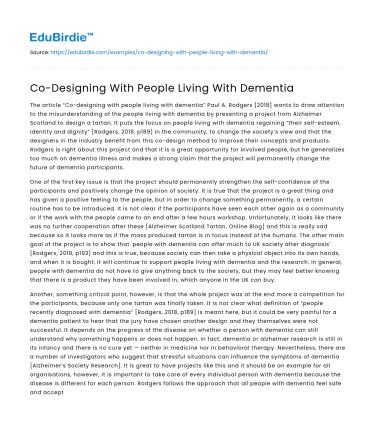The article “Co-designing with people living with dementia” Paul A. Rodgers [2018] wants to draw attention to the misunderstanding of the people living with dementia by presenting a project from Alzheimer Scotland to design a tartan. It puts the focus on people living with dementia regaining “their self-esteem, identity and dignity” [Rodgers, 2018, p189] in the community, to change the society’s view and that the designers in the industry benefit from this co-design method to improve their concepts and products. Rodgers is right about this project and that it is a great opportunity for involved people, but he generalizes too much on dementia illness and makes a strong claim that the project will permanently change the future of dementia participants.
One of the first key issue is that the project should permanently strengthen the self-confidence of the participants and positively change the opinion of society. It is true that the project is a great thing and has given a positive feeling to the people, but in order to change something permanently, a certain routine has to be introduced. It is not clear if the participants have seen each other again as a community or if the work with the people came to an end after a few hours workshop. Unfortunately, it looks like there was no further cooperation after these [Alzheimer Scotland Tartan, Online Blog] and this is really sad because so it looks more as if the mass produced tartan is in focus instead of the humans. The other main goal of the project is to show that 'people with dementia can offer much to UK society after diagnosis' [Rodgers, 2018, p193] and this is true, because society can then take a physical object into its own hands, and when it is bought, it will continue to support people living with dementia and the research. In general, people with dementia do not have to give anything back to the society, but they may feel better knowing that there is a product they have been involved in, which anyone in the UK can buy.
Save your time!
We can take care of your essay
- Proper editing and formatting
- Free revision, title page, and bibliography
- Flexible prices and money-back guarantee
Another, something critical point, however, is that the whole project was at the end more a competition for the participants, because only one tartan was finally taken. It is not clear what definition of “people recently diagnosed with dementia” [Rodgers, 2018, p189] is meant here, but it could be very painful for a dementia patient to hear that the jury have chosen another design and they themselves were not successful. It depends on the progress of the disease on whether a person with dementia can still understand why something happens or does not happen. In fact, dementia or alzheimer research is still in its infancy and there is no cure yet — neither in medicine nor in behavioral therapy. Nevertheless, there are a number of investigators who suggest that stressful situations can influence the symptoms of dementia [Alzheimer’s Society Research]. It is great to have projects like this and it should be an example for all organisations, however, it is important to take care of every individual person with dementia because the disease is different for each person. Rodgers follows the approach that all people with dementia feel safe and accepted during the workshops [Rodgers, 2018, p200], which is pretty good. Though, the project is generally not hundred percent dedicated to this - they should find another product that can be produced faster and more individually so that all 130 people living with dementia which were part of the project can see their finished and produced product on the shelves without being in a competition. A good example for that could be a napkin produced in a digital printing.
The concept that the end user works closely with the designers is well known under the co-design method. It should be used and applied much more frequently all over the world. This project was more focused to design the product instead of a discussing between designer and end user because of the need in the life of a person living with dementia. It is good that the participants just designed the tartan, because the people who have just received the diagnosis are busy enough in their everyday life with their disease. So they can just be creative and maybe forget their worries for a moment and just enjoy the time.
In general, the project of Paul A. Rodgers in cooperation with Alzheimer Scotland is a good thing and everyone should deal intensively with dementia in order to understand it. It is a pity that the project was only given once in 2015. Projects like this one are a good start and if more scientists are involved and the conditions are improved a bit, it could become a globally successful program. Hopeful that the research, the theapie and the dealing with the dementia patients develop and improve very fast.






 Stuck on your essay?
Stuck on your essay?

